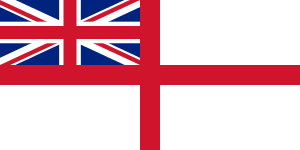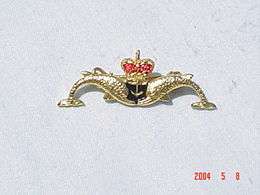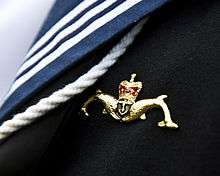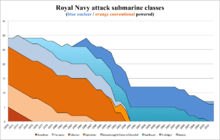Royal Navy Submarine Service
| Royal Navy Submarine Service | |
|---|---|
| Founded | 1901 |
| Country | United Kingdom |
| Allegiance | Queen Elizabeth II |
| Branch | Royal Navy |
| Motto(s) | 'We Come Unseen' |
| Equipment | 7 SSNs & 4 SSBNs |
| Website | Submarine Service |
| Commanders | |
| Commodore-in-Chief | HRH The Duke of Cambridge |
| Insignia | |
| White Ensign (1801 – present) |
 |
| Naval Jack |
 |
| Dolphin Badge |
 |
 |
| Her Majesty's Naval Service of the British Armed Forces |
|---|
| Components |
|
|
| History and future |
|
|
| Ships |
| Personnel |
| Auxiliary services |
The Royal Navy Submarine Service is the submarine element of the Royal Navy. It is sometimes known as the Silent Service, as the submarines are generally required to operate undetected.[1]
The service operates seven fleet submarines (SSNs), of the Trafalgar and Astute classes (with four currently planned or under construction), and four ballistic missile submarines (SSBN), of the Vanguard class. All of these submarines are nuclear powered. The service also owns the LR5 Submarine Rescue System.
Since 1993 the post of Flag Officer Submarines has been dual-hatted with the post of Commander Operations.
The service was for many years located at HMS Dolphin in Hampshire.[2] It moved from Dolphin to the Northwood Headquarters in 1978.[3] The Submarine School is now at HMS Raleigh at Torpoint in Cornwall.
History

At the beginning of the 20th century, the idea of submarine warfare was considered by senior personnel in the Admiralty to be "Underhand, unfair and damned un-English"[4] (Admiral Sir Arthur Wilson VC, 1901). However, those in favour of experimenting with submarine technology eventually won the argument, and the Royal Navy launched its first submarine, Holland 1, in 1901.
The Submarine Service proved its worth in World War I, where it was awarded five of the Royal Navy's 14 Victoria Crosses of the war, the first to Lieutenant Norman Holbrook, Commanding Officer of HMS B11.
On 30 August 1939 Rear Admiral Submarines, Rear Admiral Bertram Watson, moved his headquarters from Gosport to Aberdour, Scotland, though the administrative staff remained at Gosport. The RN started the Second World War with 60 submarines.[5] On 31 August 1939 Second Submarine Flotilla at Dundee (Forth and ten submarines) and Sixth Submarine Flotilla at Blyth (HMS Titania and six submarines) were part of the Home Fleet. HMS Clyde and HMS Severn, part of the Seventh Submarine Flotilla, were at Freetown under the orders of the Commander-in-Chief, South Atlantic; ten submarines were in the Mediterranean along with the depot ship HMS Maidstone (First Submarine Flotilla); and the submarine depot ship HMS Medway and the Fourth Submarine Flotilla were under the Commander-in-Chief, China, split between Singapore and Hong Kong.[6] Roskill writes that the effective naval strength of the British Empire on the outbreak of war included 38 submarines.
During the war the major operating arenas were the Norwegian waters; the Mediterranean where a flotilla of submarines fought a successful battle against the Axis replenishment route to North Africa; and the Far East where Royal Navy submarines disrupted Japanese shipping operating in the Malacca Straits.[7]
In January 1940, Vice-Admiral Max Horton was made Rear Admiral Submarines. Horton's biographer, Rear Admiral William S. Chalmers, cites the opinion that a new regulation, which required the post holder to be an officer who had served aboard submarines in the Great War, was forced through for the sole purpose of ensuring that Horton was on a very short list of qualifiers for this post, almost ensuring his rapid transfer to Aberdour, so great was the desire of some within the Admiralty to have Horton revitalize the submarine arm.[8]
In the Mediterranean (during the Siege of Malta), British U-class submarines began operations against Italy as early as June 1940. Larger submarines also began operations, but after 50% losses per mission, they were withdrawn. U-class submarines operated from the Manoel Island Base known as HMS Talbot. Unfortunately no bomb-proof pens were available as the building project had been scrapped before the war, owing to cost-cutting policies. The new force was named the Tenth Submarine Flotilla and was placed under Flag Officer Submarines, Admiral Max Horton, who appointed Commander George Simpson to command the unit.[9] Administratively, the Tenth Flotilla operated under the First Submarine Flotilla at Alexandria, itself under the admiral commanding in the Mediterranean, Cunningham. In reality, Cunningham gave Simpson and his unit a free hand. Until U-class vessels could be made available in numbers, British T-class submarines were used. They had successes, but suffered heavy losses when they began operations on 20 September 1940. Owing to the shortage of torpedoes, enemy ships could not be attacked unless the target in question was a warship, tanker or other "significant vessel".[10][11] The flotilla's performance of the fleet was mixed at first. They sank 37,000 long tons (38,000 t) of Italian shipping; half by one vessel, the submarine HMS Truant. It accounted for one Italian submarine, nine merchant vessels and one Motor Torpedo Boat (MTB). The loss of nine submarines and their trained crews and commanders was serious. Most of the losses were to mines.[12] On 14 January 1941, U-class submarines arrived, and the submarine offensive began in earnest.[13]
One of the most famous Mediterranean submarines was HMS Upholder, commanded for its entire career by Lieutenant-Commander Malcolm Wanklyn. Wanklyn received a Victoria Cross for attacking a well-defended convoy on 25 May 1941 and sinking an Italian liner, the Conte Rosso. In her 16 month operational career in the Mediterranean, before she was sunk in April 1942, Upholder carried out 24 patrols and sank around 119,000 tons of Axis ships – 3 U-boats, a destroyer, 15 transport ships with possibly a cruiser and another destroyer also sunk.
On 8 September 1944, C-in-C Mediterranean ordered that the submarine base at La Maddalena be closed, and that Tenth Flotilla be disestablished and the submarines be incorporated into the First Submarine Flotilla at Malta.[14]
The submarine force was cut back after the end of the war. The first British nuclear-powered submarine, HMS Dreadnought (S101) was launched in 1960 based around a U.S.-built nuclear reactor. This was complemented by the Valiant class from 1966, which used a new British-built Rolls-Royce PWR1 reactor. The UK's strategic nuclear deterrent was transferred to the Royal Navy from the Royal Air Force at midnight on 30 June 1968, ie 1 July. The Resolution class ballistic missile submarines (SSBNs) were introduced to carry out this role under the Polaris programme from 1968. These carried US-built UGM-27 Polaris A-3 missiles and were later replaced by the Vanguard class submarines and the Trident missile system from 1994.
In 1978 the Flag Officer Submarines who was also COMSUBEASTLANT, part of SACLANT, moved from HMS Dolphin at Gosport to the Northwood Headquarters.[15]
HMS Conqueror made history in 1982 during the Falklands War when she became the first nuclear-powered submarine to sink a surface ship, the ARA General Belgrano.
In May 1991 Oberon class submarines HMS Opossum and her sister HMS Otus returned to the submarine base HMS Dolphin in Gosport from patrol in the Persian Gulf flying Jolly Rogers, the only indication that they had been involved in alleged SAS and SBS reconnaissance operations.[16]
In 1999 HMS Splendid participated in the Kosovo Conflict and became the first Royal Navy submarine to fire a cruise missile in anger.[17]
After Operation Veritas, the attack on Al-Qaeda and Taliban forces following the September 11 attacks in the United States, it emerged that HMS Trafalgar was the first Royal Navy submarine to launch Tomahawk cruise missiles against targets in Afghanistan.[18] HMS Triumph was also involved in the initial strikes.[19] On 16 April 2003, it was reported that HMS Turbulent, the first Royal Navy vessel to return home from the war against Iraq, had launched fourteen Tomahawk cruise missiles.[20]
In 2011, HMS Triumph and Turbulent participated in Operation Ellamy. They launched Tomahawk cruise missiles at targets in Libya, firing the first shots of the operation.[21]
In April 2016, The Sunday Times reported that Royal Navy submarines were to resume under-ice operations in the Arctic.[22] Such operations have not taken place since 2007 after a fatal explosion on board HMS Tireless. The crews of all seven active Royal Navy attack submarines will receive training on how to navigate below and "punch through" ice floes.[22]
The Jolly Roger and the Submarine Service
Admiral of the Fleet Sir Arthur Wilson VC, the Controller of the Royal Navy, summed up the opinion of many in the Admiralty at the time when he said in 1901 "[Submarines are] underhand, unfair, and damned un-English. ... treat all submarines as pirates in wartime ... and hang all crews."[23][24] In response, Lieutenant Commander (later Admiral Sir) Max Horton first flew the Jolly Roger on return to port after sinking the German cruiser SMS Hela and the destroyer SMS S-116 in 1914 while in command of the E class submarine HMS E9.[25]
In World War II it became common practice for the submarines of the Royal Navy to fly the Jolly Roger on completion of a successful combat mission where some action had taken place, but as an indicator of bravado and stealth rather than of lawlessness. For example in 1982 returning from the Falklands conflict HMS Conqueror flew the Jolly Roger depicting one dagger for the SBS deployment to South Georgia and one torpedo for her sinking of the Argentinian Cruiser Belgrano. The Jolly Roger is now the emblem of the Royal Navy Submarine Service.[26]
Perisher

'Perisher' (as the Submarine Command Course is better known) is a 24-week course all officers must take prior to serving as an Executive Officer on board a Royal Navy Submarine. It has been run twice a year since 1917, usually starting on 2 July and 14 November each year. It is widely regarded as one of the toughest command courses in the world, with a historical failure rate of 25%.[27]
If at any point during the training a candidate is withdrawn from training he will be nominated for boat transfer and kept occupied until the transfer. His bag is packed for him and he is notified of the failure when the boat arrives. On departure he is presented with a bottle of whisky. A failure on Perisher means that the unsuccessful candidate is not permitted to return to sea as a member of the Submarine Service (although they are still allowed to wear the dolphin badge). He is, however, permitted to remain in the Royal Navy, moving into the surface fleet.
In more recent years, the United States Navy has sent some of its own submariner officers to undergo the 'Perisher', in order to foster and maintain closer links with the Royal Navy.
In 1995 the Royal Netherlands Navy took over the Perisher course for diesel-electric submarines, since the Royal Navy no longer operates boats of that type. The course is attended by candidate submarine commanders from navies around the world.[28]
Traditions
The Submarine Service has many traditions that are not found in the surface fleet. These include slang unique to submariners (such as referring to the torpedo storage compartment as the Bomb Shop and the diesel engine room as the Donk Shop[29]), a special communications code known as the Dolphin Code and the entitlement of a sailor to wear Dolphins upon entering the service. These are only awarded after completion of training and qualification in ships' systems during the first submarine posting (Part III training).
Problems with alcohol use while on shore leave were highlighted in the inquest following the murder on board Astute in April 2011. In February 2013 there had been over 300 disciplinary incidents in the previous three years on the RN's 13 submarines, of which 42 were substance abuse-related.[30]
Active submarines

The Submarine Service consists of two classes of Fleet submarines and one class of Ballistic Missile submarines.
Fleet submarines

There are seven fleet submarines on active duty - four Trafalgar class submarines and three Astute class submarine. They are all nuclear submarines and are classified as SSNs.[31]
These submarines are armed with the Spearfish torpedo for anti-submarine and anti-surface warfare. They have the ability to fire Tomahawk cruise missiles for attacking targets on land. This capability was used by HMS Trafalgar against the Taliban in 2001 during Operation Veritas. The Fleet submarines are also capable of surveillance and reconnaissance missions.[32] Fleet submarines are sometimes referred to as attack or hunter-killer vessels.
| Name | Class | Pennant Number | Launched |
|---|---|---|---|
| HMS Torbay | Trafalgar | S90 | 1985 |
| HMS Trenchant | Trafalgar | S91 | 1986 |
| HMS Talent | Trafalgar | S92 | 1988 |
| HMS Triumph | Trafalgar | S93 | 1991 |
| HMS Astute | Astute | S119 | 2007 |
| HMS Ambush | Astute | S120 | 2011 |
| HMS Artful | Astute | S121 | 2014 |
Ballistic submarines
The four ballistic missile submarines (SSBN) of the Royal Navy are all of the Vanguard class. They were all built by Vickers Shipbuilding and Engineering Ltd, now BAE Systems Submarine Solutions. The SSBN flotilla or bomber 'fleet' tends to be almost a separate entity; for example, it rarely uses pennant numbers preferring to use hull numbers, thus Vanguard 05, Victorious 06, Vigilant 07 and Vengeance 08.
The four Vanguard class boats are responsible for the United Kingdom's nuclear deterrent, and use the Trident missile system. Each boat can carry up to 16 Trident II D5 Missiles, each of which may carry up to 12 nuclear warheads. As of 2015, it is UK Government policy to limit the actual number of warheads carried to 40 per boat and 8 Trident Missiles.[33] There has been at least one SSBN on patrol at all times for around 40 years and since April 1969, the Royal Navy's SSBNs have not missed a single day on patrol.[34]
| Name | Class | Pennant Number | Launched |
|---|---|---|---|
| HMS Vanguard | Vanguard | S28 | 1992 |
| HMS Victorious | Vanguard | S29 | 1993 |
| HMS Vigilant | Vanguard | S30 | 1996 |
| HMS Vengeance | Vanguard | S31 | 1998 |
LR5 Submarine Rescue System
The Royal Navy operated the LR5 Submarine Rescue System, designed for retrieving sailors from stranded submarines. Capable of rescuing up to 16 sailors at a time, the system was deployed to the wreck site of the sunken submarine Kursk. The system was replaced in 2004 with the NATO Submarine Rescue System which remains based in the UK.
Decommissioning nuclear submarines
Nineteen nuclear submarines awaiting decommissioning have been laid-up at Rosyth and Devonport.[35] In 2014 the MOD announced a plan to decommission 7 of the submarines awaiting disposal, in a project expected to take 12 years. A site for the intermediate-level nuclear waste produced is expected to be identified by 2016.[36] A trial dismantling of a nuclear submarine is planned to start in January 2016 at Rosyth.[35]
Future submarines
A total force of seven Astute class fleet submarines is planned. As of April 2016, the first three boats are in commission and in service, while boats four to six are in various stages of construction. Boat number seven was confirmed in the October 2010 Strategic Defence and Security Review and long-lead items have been ordered.[37] The Astute-class submarine is the largest nuclear fleet submarine ever to serve with the Royal Navy, being nearly 30% larger than its predecessors. Its powerplant is the Rolls Royce PWR2 reactor, developed for the Vanguard-class SSBN. The submarine's armament consists of up to 38 Spearfish torpedoes and Tomahawk Block IV land-attack cruise missiles.
The replacement class for the Vanguard-class SSBNs was ordered in 2016 and is named the Dreadnought-class after its lead boat.[38][39] The programme will seek to replace one-for-one the current four ballistic missile submarines starting sometime during the late 2020s.
See also
- List of submarine classes of the Royal Navy
- List of submarines of the Royal Navy
- Royal Navy Submarine Museum
References
- ↑ "Royal Navy Submarine School". Royal Navy. Retrieved 10 April 2012.
- ↑ "Submarine School". Retrieved 6 September 2015.
- ↑ Conley, p. 136
- ↑ Stephen Wentworth Roskill (1968). Naval Policy Between the Wars, Walker, ISBN 0-87021-848-4 p. 231. cites A. J. Marder, Fear God and Dread Nought, vol. I (Oxford UP, 1961), p.333 and also Williams Jameson, The Most Formidable Thing (Hart-Davis, 1965) pp. 75-76.
- ↑ "Royal, Dominion & Allied Navies in World War 2" naval-history.net
- ↑ Stephen Roskill, History of the Second World War: The War at Sea 1939-1945: The Defensive, Chapter 4: Allied and Enemy War Plans and Dispositions, p47-49
- ↑ Submarine History : Submarine Service : Operations and Support : Royal Navy
- ↑ Chalmers, Chapter X
- ↑ Stephen P. Gill, 'Forging the Flotilla The Royal Navy’s Submarine Campaign from Malta 1940 - 1943'.
- ↑ Spooner 1996, pp. 26-27.
- ↑ Holland 2003, pp. 84–85.
- ↑ Spooner 1996, p. 29.
- ↑ Spooner 1996, p. 30.
- ↑ "The History of the British 'U' Class Submarine". Retrieved 17 January 2016.
- ↑ Royal Navy, Northwood Headquarters, accessed 22 May 2010
- ↑ "submariners.co.uk". Retrieved 17 January 2016.
- ↑ Barton Gellman U.S., NATO Launch Attacks on Yugoslavia Washington Post 25 March 1999
- ↑ Trafalgar Returns 1 March 2002
- ↑ Home and away over Christmas, Navy News, 24 December 2001
- ↑ Cruise missile sub (HMS Turbulent) back in UK by Richard Norton-Taylor in The Guardian 17 April 2003
- ↑ "British Armed Forces launch strike against Libyan Air Defence systems". Ministry of Defence. 19 March 2011. Retrieved 19 March 2011.
- 1 2 "UK attack subs return to Arctic". The Sunday Times. 10 April 2016. Retrieved 10 April 2016.
- ↑ "underhand, unfair, and damned un-English."(Stephen Wentworth Roskill (1968). Naval Policy Between the Wars, Walker, ISBN 0-87021-848-4 p. 231. cites A. J. Marder, Fear God and Dread Nought, vol. I (Oxford UP, 1961), p.333 and also Williams Jameson, The Most Formidable Thing (Hart-Davis, 1965) pp. 75-76.)
- ↑ "underhand, ... and damned Un-English. ... treat all submarines as pirates in wartime ... and hang all crews." (J. R. Hill (1989). Arms Control at Sea, Routledge, ISBN 0-415-01280-5. p.35 cites Marder, From the Drednoughts to Scapa Flow p.332)
- ↑ Webpage of the National Museum of the Royal Navy
- ↑ General information on the Royal Navy Submarine Service use and history of the Jolly Roger
- ↑ Perisher Submarine Command Training in the Royal Navy
- ↑ U.S. Submariner Qualifies for SSK Command in the RNLN Submarine Command Course
- ↑ Rick Jolly, Jackspeak: A Guide to British Naval Slang & Usage, FoSAMMA (2000), ISBN 0-9514305-2-1
- ↑ "BBC News - Submariners punished for drunken misconduct". BBC Online. Retrieved 16 February 2013.
- ↑ Royal Navy Submarines
- ↑ Fleet Submarines (SSN) : Submarine Service : Operations and Support : Royal Navy
- ↑ http://www.publications.parliament.uk/pa/cm201415/cmhansrd/cm150120/wmstext/150120m0001.htm#15012039000004
- ↑ Continuous At Sea Deterrent, royalnavy.mod.uk, Retrieved 16 June 2014
- 1 2 Jonathan Morris (3 June 2015). "Laid-up nuclear submarines at Rosyth and Devonport cost £16m". BBC. Retrieved 5 June 2015.
- ↑ "How Babcock plans to decommission UK nuclear submarines". Nuclear Engineering International. 14 February 2014. Retrieved 19 February 2014.
- ↑ Babcock contracted to provide Astute 6 & 7 weapons handling and launch system, babcockinternational.com, 1 February 2013
- ↑ "New Successor Submarines Named" (Press release). Gov.uk. 21 October 2016. Retrieved 21 October 2016.
- ↑ "New nuclear submarine given famous naval name". BBC News. Retrieved 21 October 2016.
Sources
- Chalmers, William (1954). Max Horton and the Western Approaches: A biography of Admiral Sir Max Kennedy Horton. Hodder & Stoughton.
- Conley, Dan (2014). Cold War Command: The Dramatic Story of a Nuclear Submariner. Seaforth Publishing. ISBN 9781848327696.
Further reading
- Hackmann, Willem. Seek & Strike: Sonar, anti-submarine warfare and the Royal Navy 1914-54. London: Her Majesty's Stationery Office, 1984. ISBN 0-11-290423-8
External links
- Royal Navy - Our Organisation - Submarine Service (royalnavy.mod.uk)
- Colin Mackie, Senior Royal Navy Appointments Listing including Flag Officer Submarines
- Submariners Association
.jpg)